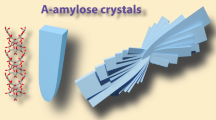Abstract
Fibrous sepiolite crystals derive much of their commercial value from their molecular size channels and grooves. The crystals fold upon drying and these channels and grooves are lost. A model for the folding and unfolding of the crystals is presented. Extensive i.r., X-ray and thermogravimetric evidence shows that folding occurs when approximately half of the water of hydration, which is coordinated to the edge magnesium atoms inside of the channels, is removed. This occurs near 175°C under vacuum and near 300°C in air. When the crystals fold, all remaining water molecules enter a new environment, that of the hexagonal holes of the neighboring silica surface. A true anhydride is produced at about 500°C under vacuum when the final water is lost, but this final dehydration produces no important structural change. Rehydration of the anhydride to the normal hydrated sepiolite does not occur at room temperatures in 100% r.h. However, above, 60°C rehydration does occur.
Similar content being viewed by others
References
Ahlrichs, J. L., Serna, C. and Serratosa, J. M. (1975) Structural hydroxyls in sepiolites. Clays and Clay Minerals 23, 119–124.
Brauner, K. and Preisinger, A. (1956) Struktur und Entstehung des Sepioliths: Tschermaks min. petr. mitt. 6, 120–140.
Caillère, S. and Henin, S. (1961) The X-ray Identification and Crystal Structures of Clay Minerals (Edited by Brown, G.). 2nd Edition, Chap. VIII, Mineralogical Society, London.
Fernandez Alvarez, T. (1970) Superficie especifica y es-tructura de poro de la sepiolita calentada a diferentes temperaturas. Proc. Reunión Hispano-Belga de Minerales de la Archilla, Madrid, pp. 202–209.
Hayashi, H., Otsuka, R. and Imai, N. (1969) I.r. study of sepiolite and palygorskite on heating. Am. Mineral. 53, 1613–1624.
Imai, N., Otsuka, R., Hayashi, H. and Kashide, H. (1969) Dehydration of palygorskite and sepiolite from the Kuzuu district, Tochigi Prefecture, Central Japan. Proc. Int. Clay Conf., Tokyo, pp. 99–108.
McDonald, R. S. (1958) Surface funtionality of amorphous silica by i.r. spectroscopy. J. Phys. Chem. 62, 1168–1178.
Nagata, M., Shimoda, S. and Sudo, T. (1974) On dehydration of bound water of sepiolite. Clays and Clay Minerals 22, 285–293.
Preisinger, A. (1959) X-ray study of the structure of sepiolite. Clays and Clay Minerals 6, 61–67.
Preisinger, A. 1963, Sepiolite and related compounds: its stability and application. Clays and Clay Minerals 10, 365–371.
Prost, R. (1973) Spectre i.r. de l’eau presente dans l’attapulgite et la sepiolite. Bull. Grpe. Fr. Argiles 25, 53–56.
Rautureau, M. and Caillère, S. (1974) Interprétation des courbes thermiques en fonction des données structurales de la sepiolite. Cr. Acad. Sci. Paris, Serie D, 278, 1661–1664.
Serna, C. (1973) Doctoral thesis, University of Madrid, Spain.
Author information
Authors and Affiliations
Rights and permissions
About this article
Cite this article
Serna, C., Ahlrichs, J.L. & Serratosa, J.M. Folding in Sepiolite Crystals. Clays Clay Miner. 23, 452–457 (1975). https://doi.org/10.1346/CCMN.1975.0230607
Received:
Accepted:
Published:
Issue Date:
DOI: https://doi.org/10.1346/CCMN.1975.0230607




